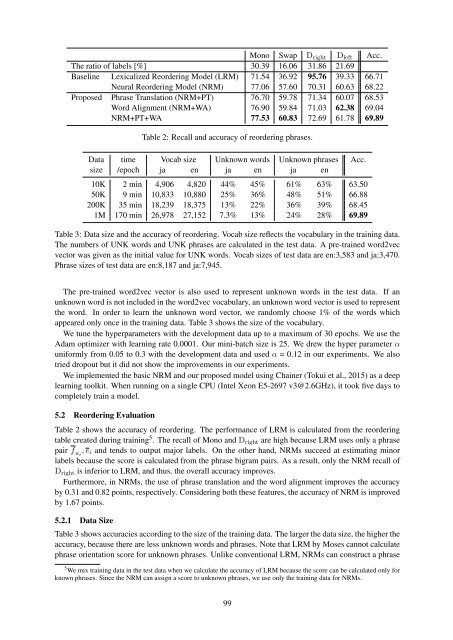December 11-16 2016 Osaka Japan
W16-46
W16-46
You also want an ePaper? Increase the reach of your titles
YUMPU automatically turns print PDFs into web optimized ePapers that Google loves.
Mono Swap D right D left Acc.<br />
The ratio of labels [%] 30.39 <strong>16</strong>.06 31.86 21.69<br />
Baseline Lexicalized Reordering Model (LRM) 71.54 36.92 95.76 39.33 66.71<br />
Neural Reordering Model (NRM) 77.06 57.60 70.31 60.63 68.22<br />
Proposed Phrase Translation (NRM+PT) 76.70 59.78 71.34 60.07 68.53<br />
Word Alignment (NRM+WA) 76.90 59.84 71.03 62.38 69.04<br />
NRM+PT+WA 77.53 60.83 72.69 61.78 69.89<br />
Table 2: Recall and accuracy of reordering phrases.<br />
Data time Vocab size Unknown words Unknown phrases Acc.<br />
size /epoch ja en ja en ja en<br />
10K 2 min 4,906 4,820 44% 45% 61% 63% 63.50<br />
50K 9 min 10,833 10,880 25% 36% 48% 51% 66.88<br />
200K 35 min 18,239 18,375 13% 22% 36% 39% 68.45<br />
1M 170 min 26,978 27,152 7.3% 13% 24% 28% 69.89<br />
Table 3: Data size and the accuracy of reordering. Vocab size reflects the vocabulary in the training data.<br />
The numbers of UNK words and UNK phrases are calculated in the test data. A pre-trained word2vec<br />
vector was given as the initial value for UNK words. Vocab sizes of test data are en:3,583 and ja:3,470.<br />
Phrase sizes of test data are en:8,187 and ja:7,945.<br />
The pre-trained word2vec vector is also used to represent unknown words in the test data. If an<br />
unknown word is not included in the word2vec vocabulary, an unknown word vector is used to represent<br />
the word. In order to learn the unknown word vector, we randomly choose 1% of the words which<br />
appeared only once in the training data. Table 3 shows the size of the vocabulary.<br />
We tune the hyperparameters with the development data up to a maximum of 30 epochs. We use the<br />
Adam optimizer with learning rate 0.0001. Our mini-batch size is 25. We drew the hyper parameter α<br />
uniformly from 0.05 to 0.3 with the development data and used α = 0.12 in our experiments. We also<br />
tried dropout but it did not show the improvements in our experiments.<br />
We implemented the basic NRM and our proposed model using Chainer (Tokui et al., 2015) as a deep<br />
learning toolkit. When running on a single CPU (Intel Xeon E5-2697 v3@2.6GHz), it took five days to<br />
completely train a model.<br />
5.2 Reordering Evaluation<br />
Table 2 shows the accuracy of reordering. The performance of LRM is calculated from the reordering<br />
table created during training 5 . The recall of Mono and D right are high because LRM uses only a phrase<br />
pair f ai<br />
, e i and tends to output major labels. On the other hand, NRMs succeed at estimating minor<br />
labels because the score is calculated from the phrase bigram pairs. As a result, only the NRM recall of<br />
D right is inferior to LRM, and thus, the overall accuracy improves.<br />
Furthermore, in NRMs, the use of phrase translation and the word alignment improves the accuracy<br />
by 0.31 and 0.82 points, respectively. Considering both these features, the accuracy of NRM is improved<br />
by 1.67 points.<br />
5.2.1 Data Size<br />
Table 3 shows accuracies according to the size of the training data. The larger the data size, the higher the<br />
accuracy, because there are less unknown words and phrases. Note that LRM by Moses cannot calculate<br />
phrase orientation score for unknown phrases. Unlike conventional LRM, NRMs can construct a phrase<br />
5 We mix training data in the test data when we calculate the accuracy of LRM because the score can be calculated only for<br />
known phrases. Since the NRM can assign a score to unknown phrases, we use only the training data for NRMs.<br />
99



